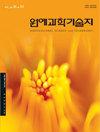1-萘乙酸对“欧文”芒果树穗部和果实特性的影响
IF 0.8
4区 农林科学
Q3 HORTICULTURE
Korean Journal of Horticultural Science & Technology
Pub Date : 2023-08-31
DOI:10.7235/hort.20230033
引用次数: 0
摘要
在温室栽培过程中,芒果的营养生长过度会抑制生殖生长,造成果实产量的损失。为了研究1-萘乙酸(NAA)处理对‘欧文’芒果品种茎尖的影响,采用30和70 mg·L-1浓度的NAA处理。随着温室温度的变化,在BBCH (Biologische, Bundesanstalt, Bundessortenamt, Chemische Industrie)尺度615和809下测定了生殖器官的特征。在花芽形成过程中,最高温度达到35℃,最低温度降至5℃;日差异在1.3至23.9°C之间。NAA处理提高了穗出芽率,减少了穗畸形。在花型上,以70 mg·L-1 NAA处理的花期明显缩短。相对穗质量指数表明,30 mg·L-1 NAA处理的树最高,其次是对照和70 mg·L-1 NAA处理的树。此外,与对照相比,NAA处理显著增加了果实的直径和重量。然而,NAA处理后硬度下降。总的来说,这项研究强调了NAA处理作为提高芒果作物产量和质量的工具的潜力,特别是在具有挑战性的环境条件下。本文章由计算机程序翻译,如有差异,请以英文原文为准。
Effects of 1-Naphthaleneacetic Acid on the Panicle and Fruit Characteristics of ‘Irwin’ Mango Trees
Excessive vegetative growth of mangoes inhibits reproductive growth during greenhouse cultivation, resulting in a loss of fruit production. To investigate the effect of a 1-naphthaleneacetic acid (NAA) treatment, two concentrations (30 and 70 mg·L-1) were applied to the shoot apices of ‘Irwin’ mango cultivars. With changes in greenhouse temperatures, the characteristics of the reproductive organs were determined at BBCH (Biologische, Bundesanstalt, Bundessortenamt, and Chemische Industrie) scales of 615 and 809. During flower bud initiation, the maximum temperature reached 35°C, and the minimum temperature dropped to 5°C; the daily difference ranged from 1.3 to 23.9°C. The NAA treatment induced increased panicle emergence rates and reduced panicle malformation. In the flowering pattern, the flowering time was reduced, especially with 70 mg·L-1 NAA. The relative panicle quality index indicated that trees treated with 30 mg·L-1 NAA had the highest value, followed by the control and those treated with 70 mg·L-1 NAA. Additionally, the NAA treatment significantly increased fruit diameters and weights compared to the control. However, firmness decreased after the NAA treatment. Overall, this study highlights the potential of a NAA treatment as a tool for improving the yield and quality of mango crops, particularly under challenging environmental conditions.
求助全文
通过发布文献求助,成功后即可免费获取论文全文。
去求助
来源期刊
CiteScore
2.00
自引率
0.00%
发文量
0
审稿时长
1 months
期刊介绍:
Horticultural Science and Technology (abbr. Hortic. Sci. Technol., herein ‘HST’; ISSN, 1226-8763), one of the two official journals of the Korean Society for Horticultural Science (KSHS), was launched in 1998 to provides scientific and professional publication on technology and sciences of horticultural area. As an international journal, HST is published in English and Korean, bimonthly on the last day of even number months, and indexed in ‘SCIE’, ‘SCOPUS’ and ‘CABI’. The HST is devoted for the publication of technical and academic papers and review articles on such arears as cultivation physiology, protected horticulture, postharvest technology, genetics and breeding, tissue culture and biotechnology, and other related to vegetables, fruit, ornamental, and herbal plants.

 求助内容:
求助内容: 应助结果提醒方式:
应助结果提醒方式:


